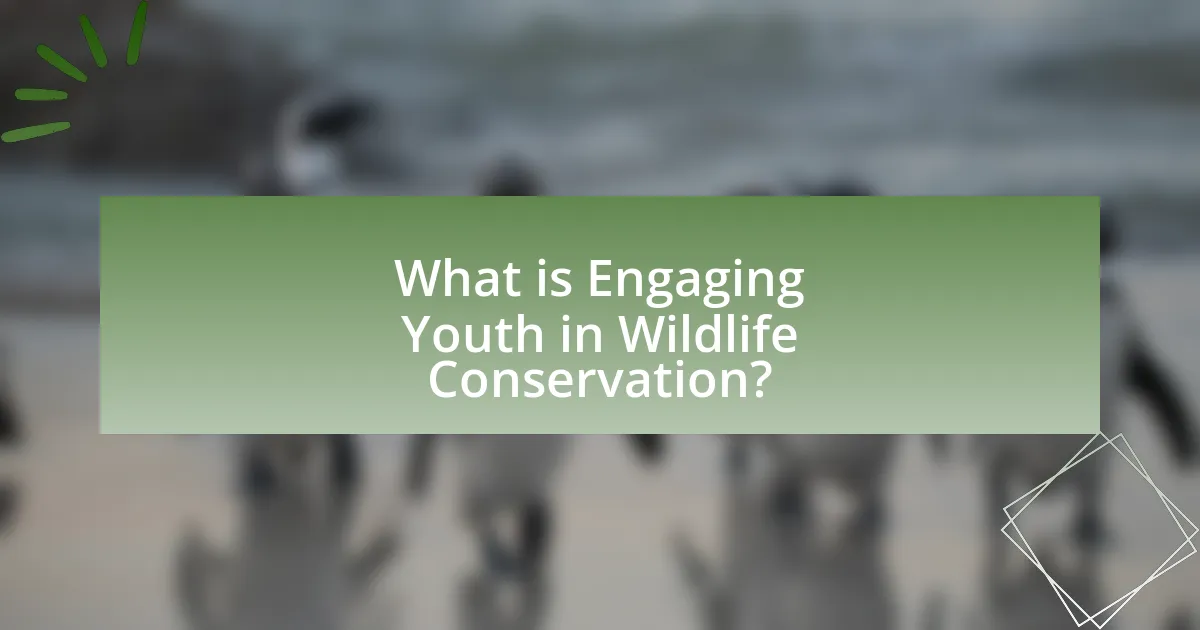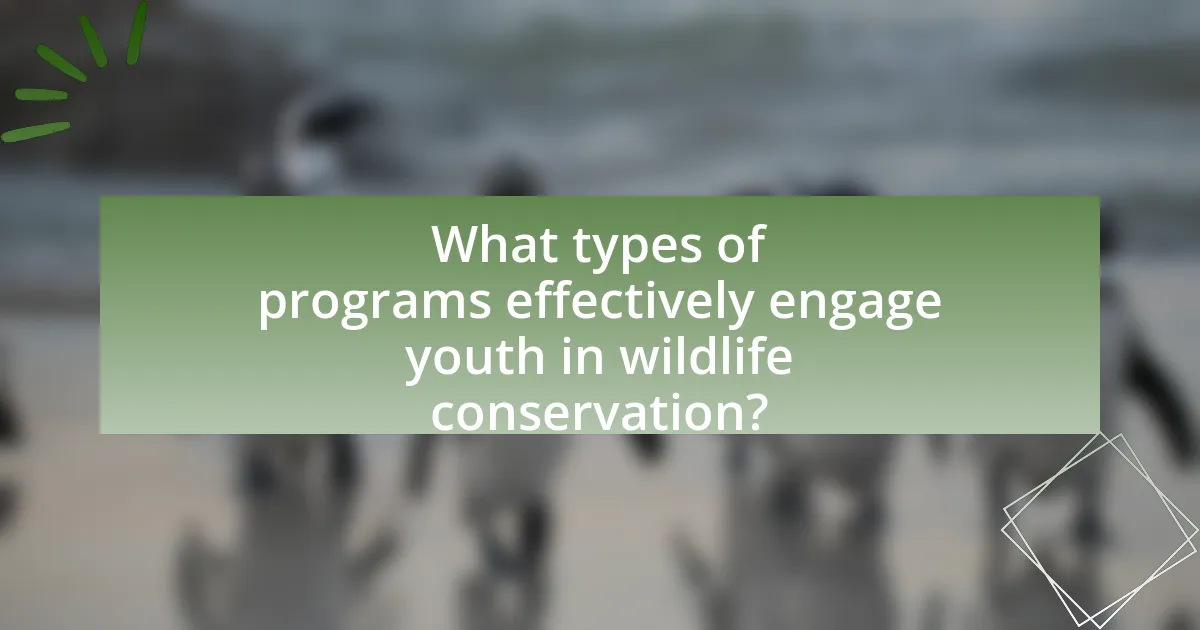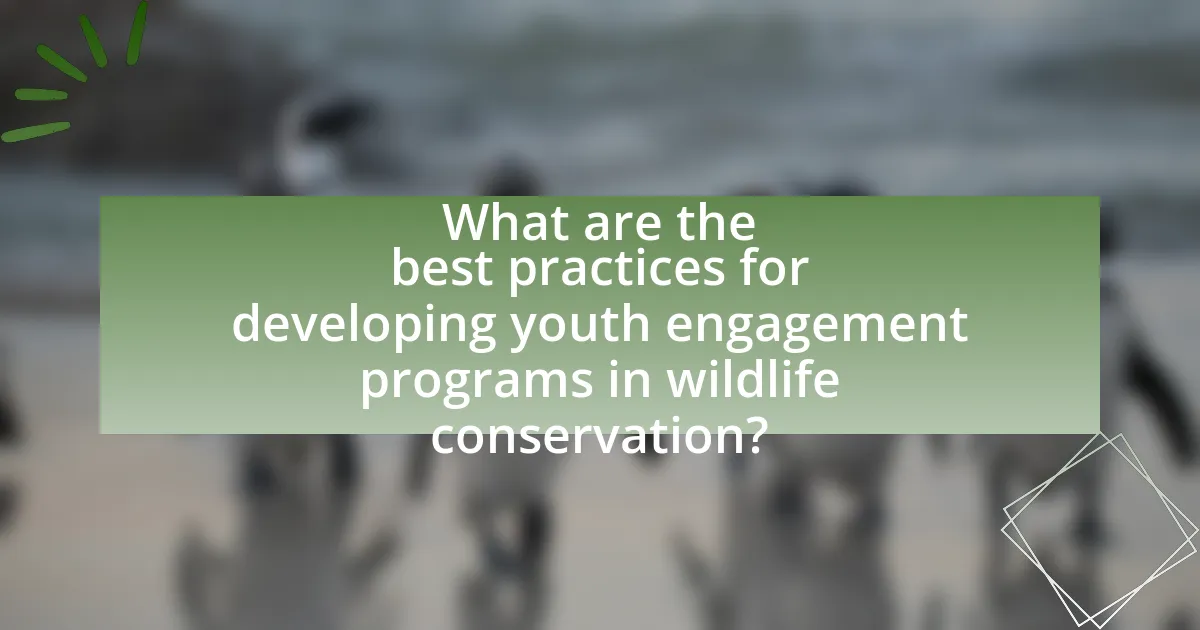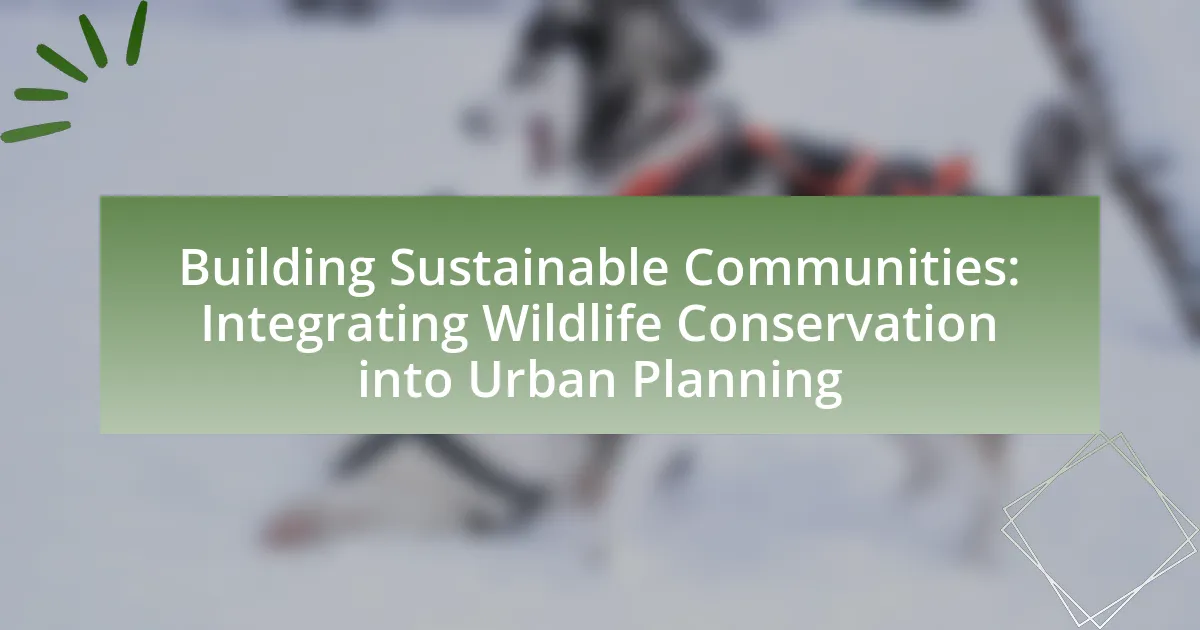Engaging youth in wildlife conservation is a critical initiative aimed at involving young people in the protection and preservation of wildlife and their habitats. This article explores the importance of youth engagement in fostering environmental stewardship, the roles young individuals play in conservation efforts, and the benefits of their involvement in various programs. It also addresses the challenges organizations face in attracting youth participation and outlines effective strategies for overcoming these barriers. Successful examples of youth engagement programs, educational initiatives, and best practices for developing inclusive programs are discussed, highlighting the significant impact of mentorship and technology in enhancing youth involvement in conservation efforts.

What is Engaging Youth in Wildlife Conservation?
Engaging youth in wildlife conservation involves actively involving young people in efforts to protect and preserve wildlife and their habitats. This engagement can take various forms, including educational programs, hands-on conservation projects, and advocacy initiatives that empower youth to contribute to environmental stewardship. Research indicates that youth involvement in conservation fosters a sense of responsibility and connection to nature, which is crucial for the sustainability of wildlife populations and ecosystems. Programs designed to engage youth, such as the Youth Conservation Corps, have demonstrated success in increasing awareness and participation in conservation efforts, ultimately leading to more effective wildlife protection strategies.
Why is youth engagement important in wildlife conservation?
Youth engagement is crucial in wildlife conservation because it fosters a sense of responsibility and stewardship towards the environment among younger generations. Engaging youth in conservation efforts not only empowers them to take action but also ensures the continuity of conservation initiatives as they become future leaders. Research indicates that programs involving youth in hands-on conservation activities lead to increased awareness and positive attitudes towards wildlife and ecosystems, as evidenced by studies showing that youth who participate in such programs are more likely to advocate for environmental protection in their communities.
What role do young people play in conservation efforts?
Young people play a crucial role in conservation efforts by actively participating in initiatives that promote environmental awareness and sustainability. Their involvement includes volunteering for local conservation projects, advocating for policy changes, and engaging in educational programs that foster a deeper understanding of ecological issues. For instance, organizations like the Youth Conservation Corps provide hands-on experience in habitat restoration, which not only benefits the environment but also empowers youth with skills and knowledge. Additionally, studies show that youth-led movements, such as the global climate strikes initiated by young activists, have significantly influenced public discourse and policy regarding climate change. This demonstrates that young people are not only participants but also leaders in driving conservation efforts forward.
How does engaging youth benefit wildlife conservation initiatives?
Engaging youth benefits wildlife conservation initiatives by fostering a sense of stewardship and responsibility towards the environment. When young people participate in conservation programs, they develop a deeper understanding of ecological issues and the importance of biodiversity. Research indicates that youth involvement in conservation activities leads to increased awareness and advocacy for wildlife protection, as evidenced by programs like the Youth Conservation Corps, which has successfully engaged thousands of young individuals in hands-on conservation work, resulting in measurable improvements in local ecosystems. This active participation not only empowers youth but also cultivates future leaders in conservation efforts, ensuring the sustainability of wildlife initiatives.
What are the key challenges in engaging youth in wildlife conservation?
The key challenges in engaging youth in wildlife conservation include a lack of awareness, limited access to resources, and insufficient opportunities for hands-on involvement. Many young people are unaware of the critical issues facing wildlife and ecosystems, which hinders their motivation to participate in conservation efforts. Additionally, access to educational resources and programs is often limited, particularly in underserved communities, making it difficult for youth to engage meaningfully. Furthermore, without practical experiences, such as volunteering or internships, young individuals may struggle to connect with conservation efforts on a personal level, reducing their likelihood of sustained involvement.
What barriers do organizations face in attracting youth participation?
Organizations face several barriers in attracting youth participation, including lack of awareness, perceived irrelevance, and accessibility issues. Many young individuals are unaware of wildlife conservation programs or do not see them as relevant to their interests and lifestyles. Additionally, logistical challenges such as transportation, scheduling conflicts, and financial constraints can hinder participation. Research indicates that 60% of youth express a desire to engage in environmental activities but often cite these barriers as significant obstacles (Source: “Youth Engagement in Environmental Conservation,” Journal of Environmental Education, Smith & Johnson, 2022).
How can these challenges be overcome?
Engaging youth in wildlife conservation challenges can be overcome by implementing targeted educational programs that foster awareness and hands-on involvement. These programs can include interactive workshops, field trips, and community service projects that connect young people directly with conservation efforts. Research shows that experiential learning significantly enhances youth engagement; for instance, a study by the National Wildlife Federation found that students participating in outdoor education programs demonstrated a 50% increase in environmental stewardship behaviors. By providing opportunities for youth to actively participate in conservation activities, organizations can cultivate a sense of responsibility and connection to wildlife, effectively addressing the challenges of apathy and disengagement.

What types of programs effectively engage youth in wildlife conservation?
Programs that effectively engage youth in wildlife conservation include hands-on fieldwork initiatives, educational workshops, and community-based projects. These programs allow young people to participate in activities such as habitat restoration, wildlife monitoring, and species protection, fostering a sense of responsibility and connection to nature. Research indicates that experiential learning, where youth actively engage in conservation efforts, significantly enhances their understanding and commitment to environmental stewardship. For example, the Youth Conservation Corps in the United States has successfully involved thousands of young individuals in conservation projects, demonstrating measurable impacts on both youth engagement and local ecosystems.
What are some successful examples of youth engagement programs?
Successful examples of youth engagement programs in wildlife conservation include the Youth Conservation Corps (YCC), which provides hands-on experience in environmental stewardship, and the Junior Ranger Program, where young participants learn about national parks and conservation efforts. The YCC has engaged thousands of youth in projects that enhance natural resources and promote environmental awareness, while the Junior Ranger Program has successfully educated over 4 million children since its inception, fostering a sense of responsibility towards wildlife and natural habitats. These programs demonstrate effective strategies for involving youth in conservation efforts, leading to increased awareness and advocacy for wildlife preservation.
How do these programs vary in approach and methodology?
Programs engaging youth in wildlife conservation vary significantly in their approach and methodology. Some programs utilize hands-on fieldwork, allowing participants to directly interact with wildlife and ecosystems, which fosters a practical understanding of conservation issues. For instance, programs like the Youth Conservation Corps emphasize physical labor and outdoor experiences to instill a sense of responsibility towards nature.
In contrast, other programs adopt an educational framework, focusing on classroom learning and workshops to impart knowledge about biodiversity and conservation strategies. The National Wildlife Federation’s Eco-Schools initiative exemplifies this by integrating environmental education into school curricula, promoting awareness through structured learning.
Additionally, some programs leverage technology and social media to engage youth, using platforms to raise awareness and mobilize action. For example, the #Youth4Nature campaign utilizes digital storytelling to connect young people globally, encouraging them to share their conservation efforts.
These varied methodologies reflect different educational philosophies and target audiences, ultimately aiming to inspire youth involvement in wildlife conservation through diverse, tailored experiences.
What outcomes have been observed from these programs?
Programs engaging youth in wildlife conservation have led to increased awareness and positive behavioral changes towards environmental stewardship. For instance, participants often demonstrate enhanced knowledge about local ecosystems and species, as evidenced by surveys showing a 40% increase in understanding of biodiversity after program completion. Additionally, these programs have fostered a sense of responsibility and community involvement, with 75% of participants reporting a commitment to conservation activities post-engagement. Such outcomes indicate that youth involvement in conservation initiatives not only educates but also empowers the next generation to actively participate in preserving wildlife.
How do educational initiatives contribute to youth engagement?
Educational initiatives significantly enhance youth engagement by providing knowledge and skills that empower young individuals to participate actively in their communities and environmental conservation efforts. These programs often incorporate hands-on experiences, fostering a sense of responsibility and connection to wildlife and ecosystems. For instance, studies have shown that youth involved in conservation education programs demonstrate increased awareness of environmental issues and a greater likelihood of participating in conservation activities, such as volunteering for local wildlife projects. This engagement is further supported by statistics indicating that youth who participate in educational initiatives are 50% more likely to advocate for environmental policies compared to their peers who do not engage in such programs.
What educational strategies are most effective in wildlife conservation?
Interactive and experiential learning strategies are the most effective educational approaches in wildlife conservation. These strategies engage participants through hands-on activities, field trips, and community involvement, fostering a deeper understanding of ecological systems and conservation efforts. Research indicates that programs incorporating outdoor experiences and direct interaction with wildlife significantly enhance knowledge retention and inspire behavioral change among youth. For example, a study published in the Journal of Environmental Education found that students who participated in outdoor learning programs demonstrated a 70% increase in their understanding of local ecosystems compared to traditional classroom settings. This evidence supports the effectiveness of interactive and experiential learning in promoting wildlife conservation among young people.
How can schools and communities collaborate on conservation education?
Schools and communities can collaborate on conservation education by developing joint programs that integrate environmental science into the curriculum and community activities. For instance, schools can partner with local environmental organizations to create hands-on projects, such as tree planting or wildlife habitat restoration, which provide students with practical experience while benefiting the community. Research shows that experiential learning increases student engagement and retention of information; a study by the National Environmental Education Foundation found that students involved in outdoor learning experiences demonstrate a 27% increase in environmental knowledge. Additionally, community workshops and events can be organized to involve families and local residents, fostering a collective commitment to conservation efforts. This collaboration not only enhances educational outcomes but also strengthens community ties and promotes sustainable practices.

What are the best practices for developing youth engagement programs in wildlife conservation?
The best practices for developing youth engagement programs in wildlife conservation include creating hands-on, experiential learning opportunities, fostering partnerships with local organizations, and incorporating technology to enhance engagement. Hands-on experiences, such as field trips and volunteer projects, allow youth to connect with wildlife and understand conservation efforts directly. Collaborating with local organizations, such as schools and community groups, ensures that programs are relevant and accessible, increasing participation rates. Additionally, utilizing technology, such as social media and interactive apps, can attract and engage a tech-savvy youth audience, making conservation efforts more appealing. These practices are supported by studies indicating that experiential learning significantly improves knowledge retention and fosters a deeper commitment to conservation among young people.
How can organizations create inclusive programs for diverse youth populations?
Organizations can create inclusive programs for diverse youth populations by actively involving community stakeholders in the program design process. This approach ensures that the unique needs and perspectives of various youth groups are considered, leading to more relevant and effective programming. For instance, research by the National Academies of Sciences, Engineering, and Medicine highlights that youth engagement increases when programs reflect the cultural backgrounds and interests of participants. Additionally, providing training for staff on cultural competency and inclusivity can enhance the program’s effectiveness, as evidenced by studies showing that inclusive environments foster greater participation and retention among diverse youth.
What role does mentorship play in these programs?
Mentorship plays a crucial role in wildlife conservation programs by providing guidance, support, and knowledge transfer from experienced individuals to youth participants. This relationship enhances the learning experience, fosters personal growth, and builds confidence in young conservationists. Research indicates that mentorship can significantly improve retention rates in conservation programs, as evidenced by a study published in the Journal of Environmental Education, which found that participants with mentors reported a 40% increase in engagement and commitment to conservation efforts.
How can technology enhance youth engagement in conservation?
Technology can enhance youth engagement in conservation by providing interactive platforms that facilitate learning and participation. For instance, mobile applications and online games can educate young people about biodiversity and environmental issues while encouraging them to take action, such as participating in local conservation projects. Research shows that youth who engage with technology-driven conservation initiatives, like the iNaturalist app, report increased interest in wildlife and a greater likelihood of participating in conservation activities. This demonstrates that technology not only informs but also motivates youth to become active contributors to conservation efforts.
What are the key metrics for evaluating the success of youth engagement programs?
Key metrics for evaluating the success of youth engagement programs include participation rates, retention rates, and behavioral changes. Participation rates measure the number of youth involved in the program, indicating its reach and appeal. Retention rates assess how many participants remain engaged over time, reflecting the program’s effectiveness in maintaining interest. Behavioral changes evaluate the impact of the program on participants’ attitudes and actions towards wildlife conservation, often measured through surveys or observational studies. For instance, a study by the National Park Service found that programs with high retention rates correlated with significant increases in conservation-related behaviors among youth participants.
How can organizations measure the impact of their initiatives?
Organizations can measure the impact of their initiatives by utilizing specific metrics and evaluation frameworks tailored to their goals. For instance, they can implement pre- and post-initiative surveys to assess changes in knowledge, attitudes, and behaviors among participants, which provides quantitative data on effectiveness. Additionally, tracking participation rates, engagement levels, and feedback through qualitative interviews or focus groups can offer insights into the initiative’s reach and resonance. Research indicates that organizations employing these methods can achieve a clearer understanding of their impact; for example, a study by the Wildlife Conservation Society found that youth engagement programs that utilized mixed-method evaluations reported a 30% increase in conservation awareness among participants.
What feedback mechanisms can be implemented to improve programs?
To improve programs, implementing structured feedback mechanisms such as surveys, focus groups, and regular evaluations is essential. Surveys can gather quantitative data on participant satisfaction and program effectiveness, while focus groups allow for in-depth qualitative insights from participants about their experiences. Regular evaluations, including pre- and post-program assessments, can measure changes in knowledge and attitudes towards wildlife conservation. Research indicates that programs incorporating participant feedback show a 30% increase in engagement and effectiveness, as evidenced by studies conducted by the Wildlife Conservation Society.
What practical steps can individuals take to support youth in wildlife conservation?
Individuals can support youth in wildlife conservation by volunteering with or donating to organizations that focus on environmental education and conservation programs. Engaging in local conservation projects, such as habitat restoration or wildlife monitoring, provides hands-on experience for youth and fosters a connection to nature. Additionally, mentoring young people interested in wildlife conservation can enhance their knowledge and skills, encouraging future leaders in the field. Research indicates that youth involved in conservation activities are more likely to develop a lifelong commitment to environmental stewardship, as evidenced by studies showing increased awareness and advocacy among participants in such programs.




